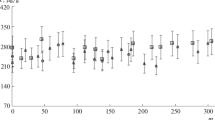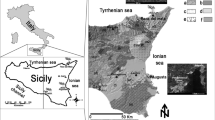Abstract
The concentrations of 17 elements in the nail and hair of 117 subjects from a nonindustrialized environment were determined by instrumental neutron activation analysis (INAA). A new method of statistical treatment that allows for more meaningful use of detection limit values was used to process the concentration data. Geometric means and standard errors are presented for each element, along with a summary of the effects of age, sex, and treatment on the concentration of each element. For nails, these data represent the first comprehensive study for several important elements. Correlations for each element between hair and nail were determined. With few exceptions, concentrations of nonessential trace elements were positively correlated in hair and nail, whereas concentrations of essential elements showed no correlations. The factors affecting concentrations and control levels must be considered in studying alterations in disease states.
Similar content being viewed by others
References
M. Ordogh, S. Fazekas, and E. Szabo,Metal Ions in Neurology and Psychiatry, S. Gabay, J. Harris, B. T. Ho, eds., Liss Inc., New York, 1985, pp. 129–137.
T. Takeuchi, H. Matsumoto, M. Sasaki, T. Kambara, Y. Shiraishi, Y. Hirata, M. Nobuhiro, and H. Ito,Kumamoto Med. J. 34, 521 (1968).
W. D. Ehmann, W. R. Markesbery, M. Alauddin, T. Hossain, and E. H. Brubaker,Neuro Tox. 7 (1), 197 (1986).
W. D. Ehmann, W. R. Markesbery, and M. Alauddin,Neurobiology of Zinc, C. J. Frederickson, G. A. Howell, and E. J. Kasarskis, eds., Liss Inc., New York, 1984, pp. 329–342.
E. J. Kasarskis, W. D. Ehmann, S. Khare, and W. R. Markesbery,Neurology 37, Supp. 1, 162 (1987).
Y. S. Ryabukhin,J. Radioanal. Chem. 60 (1), 7 (1980).
H. C. Hopps,Sci. Total Environ. 7, 71 (1977).
V. Valkovic,Trace Elements in Human Hair, Garland STPM Press, New York, 1977, 194 pp.
E. L. Kanabrocki, J. A. Kanabrocki, J. Greco, E. Kaplan, and Y. T. Oester,Sci. Total Environ. 13, 131 (1979).
S. K. Biswas, M. Abdullah, S. Akhter, S. A. Tarafdor, M. Khaliquzzaman, and A. H. Khan,J. Radioanal. Nucl. Chem. 82 (1), 111 (1984).
Activation Analysis of Hair as an Indicator of Contamination of Man by Environmental Trace Element Pollutants. International Atomic Energy Agency, IAEA/RL/50, Vienna, Austria, 1978, 135 pp.
S. Ohmori, H. Tsuji, Y. Kusaka, T. Takeuchi, T. Hayashi, J. Takada, M. Koyama, H. Kozuka, M. Shinogi, A. Aoki, K. Katayama, and T. Tomiyama,J. Radioanal. Chem. 63 (2), 269 (1981).
A. Imahori, I. Fukushima, S. Shiobara, Y. Yanagida, and K. Tomura,J. Radioanal. Chem. 52, 167 (1979).
T. Nishihara, K. Watabe, T. Ichikawa, and M. Kondo,Chemosphere 14 (8), 1133 (1985).
L. Currie,Anal. Chem. 40, 586 (1969).
W. D. Ehmann, W. R. Markesbery, M. Alauddin, D. T. Goodin, and T. Hossain,Nuclear Methods in Environmental and Energy Research, Fourth International Conference, Columbia, MO, April 1980, CONF-800433, US Department of Energy, pp. 459–469.
D. E. Vance,Trace Element Relationships in Alzheimer’s Disease: Hair and Nail Analysis by INAA, Ph.D. Dissertation, University of Kentucky, 1986, 317 pp.
R. A. Nadkarni and W. D. Ehmann,J. Radioanal. Chem. 3, 175 (1969).
SAS Institute,SAS User’s Guide: Statistics, Version 5th Edition, SAS Institutes, Inc., Cary, NC, 1985.
M. Kamakura,Nippon Eiseigaku Zasshi,38 (5), 823 (1983).
K. Izumi,Tokyo Ika Daigaku Zasshi,41 (1), 43 (1983).
M. Huang, G. Liang, D. Huang, L. Shen, Y. Xu, J. Zhang, Z. Xiang, X. Wang, Z. Chen, and W. Yu,Zhonghua Yixue Zazhi,62(3), 134 (1982).
T. Takeuchi, T. Hayashi, J. Takada, Y. Hayashi, M. Koyama, H. Kozuka, H. Tsuji, Y. Kusaka, S. Ohmori, M. Shinogi, A. Aoki, K. Katayama, and T. Tomiyama,J. Radioanal. Chem. 70 (1–2), 29 (1982).
J. C. Hansen, H. C. Wulf, N. Kromann, and K. Alboege,Sci. Total Environ. 26 (3), 233 (1983).
G. V. Iyengar, W. E. Kollmer, and H. J. M. Bowen,The Elemental Composition of Human Tissues and Body Fluids, Verlag Chemie, New York, 1978, 151 pp.
U. Tomza and W. Maenhaut,J. Radioanal. Nucl. Chem. 86 (4), 209 (1984).
Author information
Authors and Affiliations
Rights and permissions
About this article
Cite this article
Vance, D.E., Ehmann, W.D. & Markesbery, W.R. Trace element content in fingernails and hair of a nonindustrialized US control population. Biol Trace Elem Res 17, 109–121 (1988). https://doi.org/10.1007/BF02795450
Received:
Accepted:
Issue Date:
DOI: https://doi.org/10.1007/BF02795450




